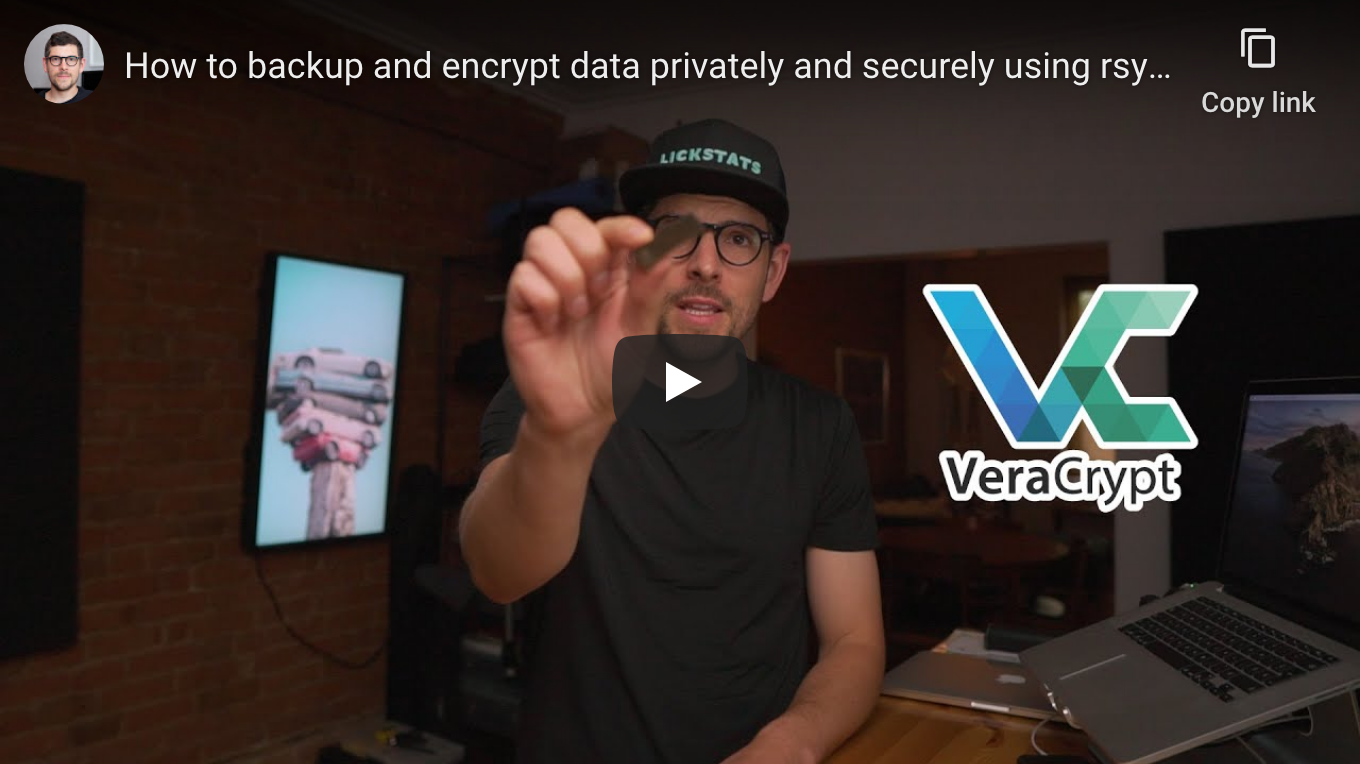| .. | ||
| how-to-backup-and-encrypt-data-privately-and-securely-using-rsync-and-veracrypt-on-macos.png | ||
| README.md | ||
How to backup and encrypt data privately and securely using rsync and VeraCrypt on macOS
Requirements
- Computer running macOS Mojave or Catalina
Caveats
- When copy/pasting commands that start with
$, strip out$as this character is not part of the command - When copy/pasting commands that start with
cat << "EOF", select all lines at once (fromcat << "EOF"toEOFinclusively) as they are part of the same (single) command
Setup guide
Step 1: download and install FUSE
Go to https://osxfuse.github.io/, download and install latest release.
Step 2: install GnuPG
Follow steps from How to encrypt, sign and decrypt messages using PGP on macOS (adding privacy to email) guide.
Step 3: import VeraCrypt’s public key
$ gpg --keyserver hkps://keys.openpgp.org --recv-keys 0x821ACD02680D16DE
gpg: key 0x821ACD02680D16DE: public key "VeraCrypt Team (2018 - Supersedes Key ID=0x54DDD393) <veracrypt@idrix.fr>" imported
gpg: Total number processed: 1
gpg: imported: 1
Step 4: download VeraCrypt
Go to https://www.veracrypt.fr/en/Downloads.html and download latest release and its associated PGP signature to ~/Downloads folder.
Step 5: verify VeraCrypt release signature using GnuPG
Replace VeraCrypt_1.24-Update7 with current release.
$ gpg --verify ~/Downloads/VeraCrypt_1.24-Update7.dmg.sig
gpg: assuming signed data in '/Users/sunknudsen/Downloads/VeraCrypt_1.24-Update7.dmg'
gpg: Signature made Sat 8 Aug 14:20:27 2020 EDT
gpg: using RSA key 5069A233D55A0EEB174A5FC3821ACD02680D16DE
gpg: Good signature from "VeraCrypt Team (2018 - Supersedes Key ID=0x54DDD393) <veracrypt@idrix.fr>" [unknown]
gpg: WARNING: This key is not certified with a trusted signature!
gpg: There is no indication that the signature belongs to the owner.
Primary key fingerprint: 5069 A233 D55A 0EEB 174A 5FC3 821A CD02 680D 16DE
Good signature
👍
Step 6: install VeraCrypt
Step 7: create and test VeraCrypt symlink
$ ln -s /Applications/VeraCrypt.app/Contents/MacOS/VeraCrypt /usr/local/bin/veracrypt
$ veracrypt --text --version
VeraCrypt 1.24-Update7
VeraCrypt 1.24-Update7
👍
Step 8: set temporary environment variable
Heads up: using
.bas encrypted volume path to make things inconspicuous (files that start with.are hidden on macOS, use cmd+shift+. to display them).
BACKUP_VOLUME_PATH path to VeraCrypt volume
BACKUP_VOLUME_PATH="/Volumes/Samsung BAR/.b"
Step 9: create encrypted volume
Heads up: volume size cannot be increased later.
Heads up: Mac OS Extended filesystem required on macOS.
$ veracrypt --text --create "$BACKUP_VOLUME_PATH"
Volume type:
1) Normal
2) Hidden
Select [1]:
Enter volume size (sizeK/size[M]/sizeG): 1G
Encryption Algorithm:
1) AES
2) Serpent
3) Twofish
4) Camellia
5) Kuznyechik
6) AES(Twofish)
7) AES(Twofish(Serpent))
8) Camellia(Kuznyechik)
9) Camellia(Serpent)
10) Kuznyechik(AES)
11) Kuznyechik(Serpent(Camellia))
12) Kuznyechik(Twofish)
13) Serpent(AES)
14) Serpent(Twofish(AES))
15) Twofish(Serpent)
Select [1]:
Hash algorithm:
1) SHA-512
2) Whirlpool
3) SHA-256
4) Streebog
Select [1]:
Filesystem:
1) None
2) FAT
3) Mac OS Extended
4) exFAT
5) APFS
Select [3]:
Enter password:
Re-enter password:
Enter PIM:
Enter keyfile path [none]:
Please type at least 320 randomly chosen characters and then press Enter:
Done: 100.000% Speed: 245 MiB/s Left: 0 s
The VeraCrypt volume has been successfully created.
Step 10 (optional): mount, rename and dismount encrypted volume
By default, VeraCrypt encrypted volumes are named "untitled".
Mount encrypted volume
$ veracrypt --text --mount --pim 0 --keyfiles "" --protect-hidden no "$BACKUP_VOLUME_PATH" /Volumes/Backup
Enter password for /Volumes/SAMSUNG BAR/.b:
Rename encrypted volume
$ diskutil rename "untitled" "Backup"
Volume on disk3 renamed to Backup
Dismount encrypted volume
veracrypt --text --dismount "$BACKUP_VOLUME_PATH"
Step 11: create backup script
cat << EOF > /usr/local/sbin/backup.sh
#! /bin/sh
set -e
if [ "\$(id -u)" != "0" ]; then
echo "This script must run as root"
exit 1
fi
red=$'\e[1;31m'
end=$'\e[0m'
veracrypt --text --mount --pim 0 --keyfiles "" --protect-hidden no "$BACKUP_VOLUME_PATH" /Volumes/Backup
declare -a files=(
"/Users/$(whoami)/.gnupg"
"/Users/$(whoami)/.ssh"
"/Users/$(whoami)/Library/Keychains"
)
for file in "\${files[@]}"; do
rsync -axRS --delete "\$file" /Volumes/Backup
done
printf "\${red}Inspect backup and press enter\${end}"
read -r answer
veracrypt --text --dismount "$BACKUP_VOLUME_PATH"
echo "Done"
EOF
chmod +x /usr/local/sbin/backup.sh
Step 12: edit backup script
vi /usr/local/sbin/backup.sh
Press i to enter insert mode, edit backup script, press esc to exit insert mode and press shift+z+z to save and exit.
Usage guide
$ sudo backup.sh
Password:
Enter password for /Volumes/Samsung BAR/.b:
Inspect backup and press enter
Done
Done
👍
